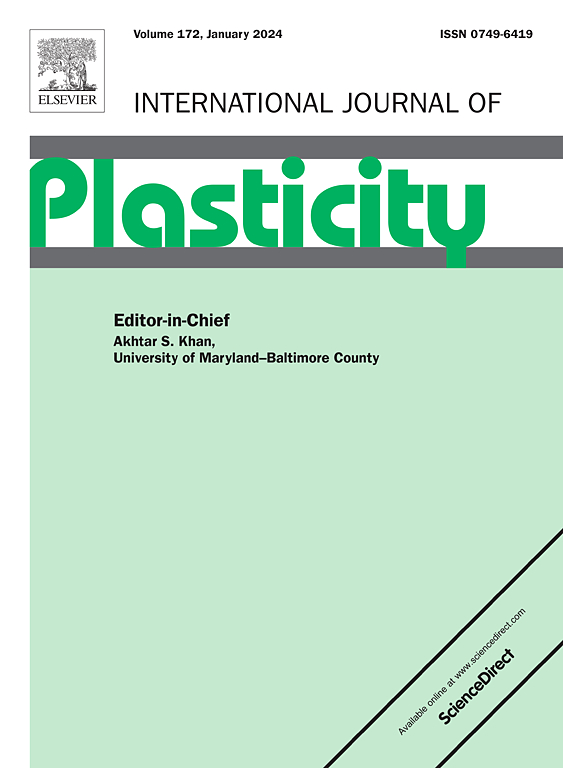电子束线喂增材制备Ti-6Al-3Nb-2Zr-1Mo合金低温力学性能的相互滑移和孪生行为
IF 12.8
1区 材料科学
Q1 ENGINEERING, MECHANICAL
引用次数: 0
摘要
具有六方密堆积(HCP)结构的α-Ti具有优异的强度重量比和结构稳定性,成为极端条件下有前途的材料。然而,由于多孔性、夹杂物、氧化和残余应力对机械性能的不利影响,关于低温应用的增材制造钛合金的报道很少。同时,α-Ti合金的低温应用也面临着强度-延性平衡的挑战。这项工作成功地证明了电子束线喂增材制造(EBWF AM)制造高性能低温钛合金的可行性。几乎致密的Ti-6Al-3Nb-2Zr-1Mo (Ti6321)合金在低温条件下的屈服强度为1194 MPa,总伸长率为18.8%,与室温相比,延展性和强度分别提高了30%和64%。高吸引力的低温延展性归因于相互依存的滑移和孪生行为在调解低温变形。其中,棱柱滑移和基底滑移成为主要的变形模式。然而,篮织形态受益于更多的< c + a >位错、丰富的几何必要位错和位错离域,有助于提高低温延展性和加工硬化。宏观剪切带的抑制有助于提高低温延展性,这是由于两相和随机α变体的共变形能力,促进了变形的局部化,减轻了局部化效应。相反,在全层状微观结构中,亚毫米集落诱发了更多的变形孪晶,而滑移长度的增加和面滑移倾向加剧了应变局部化和试样宏观剪切带化,导致过早破坏。这些发现突出了超低温强度-延性组合以及位错主导的塑性低温变形在编织组织中的重要作用。这项工作证明了EBWF在制造用于低温应用的先进结构材料方面的潜力,并推进了对Ti6321低温变形行为的理解,为开发高性能钛合金提供了见解。本文章由计算机程序翻译,如有差异,请以英文原文为准。
Interdependent slip and twinning behaviors for improving cryogenic mechanical properties in Ti-6Al-3Nb-2Zr-1Mo alloy additively manufactured by electron beam wire-fed
α-Ti with hexagonal close-packed (HCP) structure offers exceptional strength-to-weight ratios and structural stability, becoming a promising material for extreme conditions. However, there are few reports on additively manufactured Ti alloys for cryogenic application, primarily due to the detrimental effects of porosity, inclusions, oxidation and residual stresses on mechanical performance. And the strength-ductility trade-off also challenges cryogenic applications of α-Ti alloys. This work successfully demonstrates the feasibility of electron beam wire-fed additive manufacturing (EBWF AM) for fabrication of high-performance cryogenic Ti alloys. The virtually dense Ti-6Al-3Nb-2Zr-1Mo (Ti6321) alloys exhibit yield strength of 1194 MPa and total elongation of 18.8 % at cryogenic conditions, with ∼30 % and ∼64 % improvements in ductility and strength compared to room temperature. The highly attractive cryogenic ductility is ascribed to the interdependent slip and twinning behavior in mediating cryodeformation. Specifically, the prismatic and basal 〈a〉 slips become primary deformation modes. However, the basketweave morphology benefits from more 〈c + a〉 dislocations, abundant geometrically necessary dislocations and dislocation delocalization, helping to improve cryogenic ductility and work hardening. Also, the inhibition of macro shear bands makes a contribution to the improved cryogenic ductility owing to the co-deformability of both phases and random α variants, facilitating deformation delocalization and mitigating localization effect. Instead, the sub-millimeter colonies in the fully lamellar microstructure induce more deformation twinning, while the enhanced slip lengths and planar slip propensity exacerbate strain localization and sample-scale macro shear banding, leading to premature failure. These findings highlight the superior cryogenic strength-ductility combination and important contribution of dislocation-dominated plastic cryodeformation in the basketweave microstructure. This work demonstrates the potential of EBWF for fabricating advanced structural materials for cryogenic applications and advances the understanding of Ti6321 cryodeformation behavior, offering insights for developing high-performance Ti alloys.
求助全文
通过发布文献求助,成功后即可免费获取论文全文。
去求助
来源期刊

International Journal of Plasticity
工程技术-材料科学:综合
CiteScore
15.30
自引率
26.50%
发文量
256
审稿时长
46 days
期刊介绍:
International Journal of Plasticity aims to present original research encompassing all facets of plastic deformation, damage, and fracture behavior in both isotropic and anisotropic solids. This includes exploring the thermodynamics of plasticity and fracture, continuum theory, and macroscopic as well as microscopic phenomena.
Topics of interest span the plastic behavior of single crystals and polycrystalline metals, ceramics, rocks, soils, composites, nanocrystalline and microelectronics materials, shape memory alloys, ferroelectric ceramics, thin films, and polymers. Additionally, the journal covers plasticity aspects of failure and fracture mechanics. Contributions involving significant experimental, numerical, or theoretical advancements that enhance the understanding of the plastic behavior of solids are particularly valued. Papers addressing the modeling of finite nonlinear elastic deformation, bearing similarities to the modeling of plastic deformation, are also welcomed.
 求助内容:
求助内容: 应助结果提醒方式:
应助结果提醒方式:


